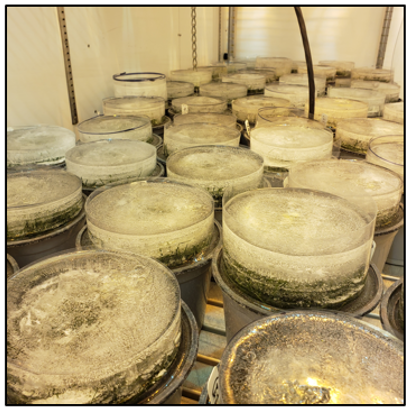By Megan Gendjar, Devendra Prasad Chalise, and Emily Merewitz Holm, Ph.D.; Michigan State University
Ice encasement is a recurring and potentially lethal stress for turfgrasses, particularly for golf course putting greens. Annual bluegrass and creeping bentgrass are different in ice encasement tolerance, with annual bluegrass surviving about half the amount of time compared to creeping bentgrass. Physiological mechanisms associated with creeping bentgrass ice encasement tolerance and annual bluegrass susceptibility are not understood. Plants undergo several physical, physiological, and metabolic changes in response to prolonged ice encasement during winter dormancy. In ice encasement sensitive species, major damage can happen to plant membrane structures, including cellular membranes and other important membranes that function as a physical location for photosynthetic and respiratory reactions. This damage can result in metabolite leakage or changes in metabolic potential.
As part of the WinterTurf project, we investigated changes in metabolites in creeping bentgrass and annual bluegrass in response to 0 and 20 days of ice encasement within controlled low temperature growth chamber conditions (Figure 1). We investigated various responses, but some highlights of the results indicate that the changes in sugars and amino acids may be important. Sugars are required during dormancy for maintenance respiration to keep overwintering structures alive. Amino acids are the building blocks of proteins and can improve plant tolerance to abiotic stress in various ways, such as serving as osmolytes, reducing oxidative stress, maintaining intracellular pH, acting as reserves of carbon and nitrogen for the synthesis of various enzymes and secondary metabolites for growth. Sufficient sugars and amino acids are also crucial to the spring recovery process and are used for new growth and building plant structures.

In the study, as expected, creeping bentgrass plants recovered at a faster rate following both 0 and 20 days of ice encasement compared to annual bluegrass. Plants took about 8 days to reach 70 to 80% green coverage for the 0-day ice encasement treatment, while it took about 13 days for creeping bentgrass and 30 days for annual bluegrass to reach about 80% green cover (Figure 2). The low numbers of percent green color at the outset of recovery are characteristic of the lack of green color during dormancy and a longer length of time to recovery indicates plant damage.

Ice encasement and dormancy generally caused a reduction of total sugar and amino acid content for both species (Figure 3). However, greater losses of both amino acids and sugars were found for annual bluegrass compared to creeping bentgrass. Creeping bentgrass did not exhibit a statistically significant loss of sugars or amino acids averaged across all plant organs (leaves, crowns, and roots). Annual bluegrass had a great loss of sugars and amino acids, which was a loss of approximately 50% for each group of metabolites due to 20 days of ice encasement and dormancy. Additional investigations into specific important sugars and amino acids in each organ are ongoing. A better understanding of these physiological differences and survival mechanisms between the two species will ultimately be useful in developing winter-resistant turfgrass varieties and assist in developing new management strategies to help turf survive the winter.
